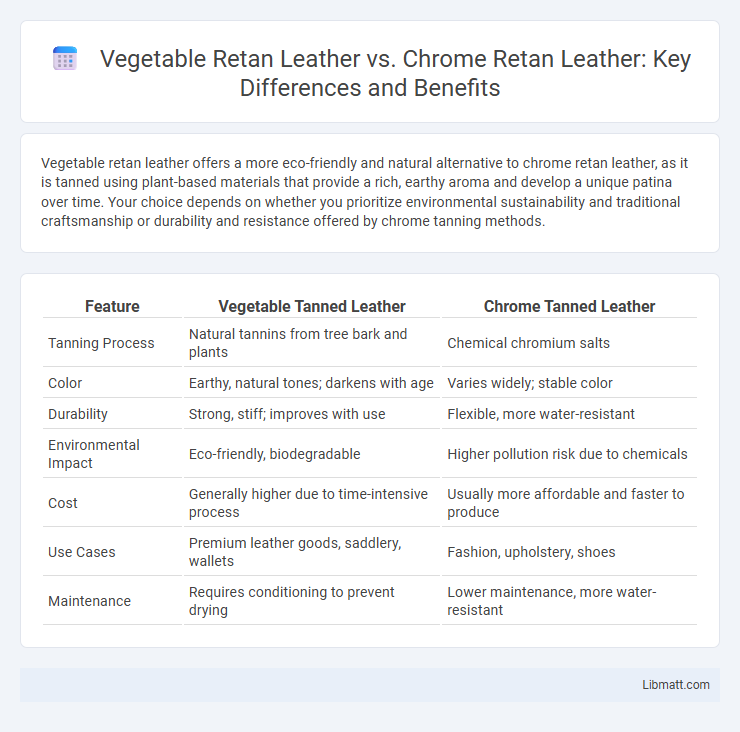Vegetable retan leather offers a more eco-friendly and natural alternative to chrome retan leather, as it is tanned using plant-based materials that provide a rich, earthy aroma and develop a unique patina over time. Your choice depends on whether you prioritize environmental sustainability and traditional craftsmanship or durability and resistance offered by chrome tanning methods.
Table of Comparison
| Feature | Vegetable Tanned Leather | Chrome Tanned Leather |
|---|---|---|
| Tanning Process | Natural tannins from tree bark and plants | Chemical chromium salts |
| Color | Earthy, natural tones; darkens with age | Varies widely; stable color |
| Durability | Strong, stiff; improves with use | Flexible, more water-resistant |
| Environmental Impact | Eco-friendly, biodegradable | Higher pollution risk due to chemicals |
| Cost | Generally higher due to time-intensive process | Usually more affordable and faster to produce |
| Use Cases | Premium leather goods, saddlery, wallets | Fashion, upholstery, shoes |
| Maintenance | Requires conditioning to prevent drying | Lower maintenance, more water-resistant |
Introduction to Retan Leather
Retan leather, a distinctive type of leather, is crafted using two primary tanning methods: vegetable tanning and chrome tanning. Vegetable retan leather involves natural tannins from plant sources, offering durability and a rich, earthy aroma, while chrome retan leather relies on chromium salts, resulting in enhanced softness and greater water resistance. Understanding these tanning processes highlights the unique textures, aging properties, and environmental impacts inherent to each type of retan leather.
What is Vegetable Retan Leather?
Vegetable retan leather is a sustainable, eco-friendly alternative to chrome retan leather, tanned using natural plant-based tannins extracted from tree bark, leaves, and fruits. This traditional tanning method enhances leather's durability, develops a rich patina over time, and avoids harmful chemicals found in chrome retan leather, making it safer for both the environment and your health. Choosing vegetable retan leather supports slower, artisanal production processes that emphasize quality and environmental responsibility.
What is Chrome Retan Leather?
Chrome retan leather is a type of leather tanned using chromium salts, primarily chromium sulfate, which accelerates the tanning process and enhances the leather's durability and flexibility. This method results in a softer, more pliable leather with excellent water resistance, making it a popular choice for fashion, upholstery, and automotive industries. In contrast to vegetable retan leather, chrome retan leather requires less processing time and offers superior resistance to heat and wear.
Tanning Processes Compared
Vegetable tanned leather is processed using natural tannins extracted from tree bark, leaves, and other plant materials, resulting in a more eco-friendly and durable leather that develops a unique patina over time. Chrome tanned leather utilizes chromium salts in a faster, more industrialized tanning method, offering greater softness, water resistance, and color consistency but with higher environmental impact. Understanding these tanning processes helps you choose the right leather type based on durability, ecological footprint, and aesthetic preferences.
Durability: Vegetable vs Chrome Retan
Vegetable retan leather offers superior durability due to its natural tanning process, which allows the material to develop a rich patina and become stronger over time. Chrome retan leather is typically more resistant to water and stains but may wear out faster under heavy use compared to vegetable retan leather. Your choice should consider the specific durability needs, with vegetable retan leather excelling in longevity and chrome retan leather providing more initial resistance to environmental factors.
Environmental Impact
Vegetable retan leather uses natural tannins derived from tree bark and plants, resulting in a more eco-friendly tanning process with lower water pollution and reduced chemical waste compared to chrome retan leather. Chrome retan leather relies on chromium salts, which can cause significant environmental harm through toxic wastewater if not properly managed. Choosing vegetable retan leather supports sustainability by minimizing harmful chemical exposure and promoting biodegradable materials in your leather goods.
Aesthetic Differences
Vegetable retan leather features a natural, matte finish with rich, earthy tones that develop a unique patina over time, enhancing its rustic charm and character. Chrome retan leather offers a smoother, glossier surface with vibrant, uniform colors that maintain their brightness and consistency longer. Your choice between these leathers affects the aesthetic appeal and aging quality, with vegetable retan leather providing a more organic look while chrome retan leather delivers a polished, modern appearance.
Cost and Accessibility
Vegetable-tanned leather typically incurs higher production costs due to its lengthy curing process, making it less accessible and more expensive for consumers compared to chrome-tanned leather. Chrome-tanned leather benefits from faster processing times and lower material expenses, resulting in more affordable prices and widespread availability in the market. The cost differential often leads manufacturers to favor chrome tanning for mass production, while vegetable tanning remains preferred for premium, artisanal products.
Ideal Uses for Each Type
Vegetable retan leather is ideal for crafting high-end leather goods like wallets, belts, and saddlery, where durability and a natural patina over time are desired. Chrome retan leather excels in producing soft, flexible items such as handbags, shoes, and upholstery, benefiting from its water-resistant and color-retentive properties. Your choice between the two should consider the product's intended use, longevity, and the aesthetic qualities you prefer.
Choosing the Right Retan Leather
Choosing the right retan leather depends on durability, environmental impact, and aesthetics. Vegetable retan leather offers natural tanning using plant-based tannins, resulting in a more eco-friendly, biodegradable material with a richer, varying patina over time. Chrome retan leather, tanned with chromium salts, provides superior water resistance, softness, and faster processing, making it ideal for mass production and items requiring high flexibility.
Vegetable retan leather vs chrome retan leather Infographic

 libmatt.com
libmatt.com